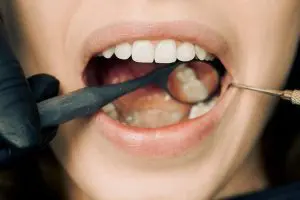Whether you’re someone who hasn’t flossed in ten years or are diligent about daily flossing, brushing, and oral hygiene, cavities can creep up when you least expect them. Cavities have a lot to do with your regular dental habits, but they also have to do with genetics. Two people can have the same dental habits, while one has had five cavities and the other has had zero. So, if you have a cavity and need a filling, you shouldn’t be so hard on yourself.
If you’ve never had a cavity before and are nervous about having a metal topped tooth for the rest of your existence, we have good news for you. Metal tooth fillings are becoming a thing of the past and tooth-colored fillings are quickly replacing them.

(Arvind Philomin/pexels)
The Different Types of Tooth Fillings
Tooth fillings help restore a tooth’s functionality, integrity, and shape affected by damage such as decay. Let’s explore the differences between traditional fillings that leave you with that piece of metal in your mouth and tooth-colored fillings that blend in.
Traditional Fillings
Back in the day, dentists only offered gold fillings or fillings made of other metal and mercury mixtures. These are called amalgam fillings. These fillings get the job done and help to restore the tooth, but they are highly visible and like a magnet to the eye when you smile or open your mouth.
Metal fillings also conduct cold and heat differently than natural teeth, causing sensitivity to hot or cold foods and beverages. Metal also requires a dentist to remove more of your dental enamel before filling to ensure proper placement and fit.
Tooth-Colored Fillings
Tooth-colored fillings are an updated and improved solution made of composite materials, often a blend of plastic resin and a more rigid material such as quartz or glass. These materials allow them to blend in with your teeth and be unnoticeable when you smile or open your mouth. They also don’t affect your teeth’ sensitivity like traditional fillings. This means you don’t have to be afraid when indulging in your favorite ice cream.
Tooth-colored fillings are also safer than traditional metal fillings because they don’t contain mercury, which has been linked to many health concerns. Tooth-colored fillings are not made from any toxic ingredients at all.
Tooth-colored fillings are durable and can last for several years. They are also faster to place than traditional fillings because they bond to your tooth and harden under a curing light.
Of course, the top reason for getting a filling is to treat a cavity. Other reasons to get a tooth-colored filling include:
- Correcting a non-cavity hole in a tooth to keep bacteria out
- Correcting tooth discoloration
- Repairing a fractured tooth
- Repairing a chipped tooth
Are Fillings Painful?
While you may leave the dentist with some numbness, fillings shouldn’t hurt. Your Weber County dentist will use a local anesthetic before drilling so you won’t feel anything. The anesthetic may take a while to wear off, so you may feel numb in that area for a few hours after your appointment.
The throbbing pain of an untreated cavity is way more than a bit of numbness. Don’t put off getting your cavity filled. You may feel minor soreness when the numbness wears off, but it won’t be anything too bad.
How Long Can a Cavity Be Left Untreated?
If your dentist says you need a cavity and you’re surprised because you have no pain at all, consider yourself lucky. It means your dentist caught the cavity while it was still minor enough to fix with a simple filling. That’s why your bi-annual Utah dentist check-ups are crucial. The goal is always to treat a cavity as soon as possible. The longer you wait to treat it, the more dreadful, painful, and expensive it will become.
We want to catch cavities in the early stages when they are still small. You likely won’t have much pain or sensitivity, and your dental health is not severely compromised yet. You don’t want to wait so long that you need a root canal.
How Long Do Fillings Typically Last?
Tooth-colored fillings should last over a decade. Try not to clench or grind your teeth, as those habits can decrease the lifespan of your fillings. If you have sensitivity or pain around your fillings, call your dentist immediately to see what is happening. It may be time to get your filling replaced.
Once you get a filling, your dentist will continue to monitor them at every dental check-up. After having them in for a long time, your dentist might do some X-rays to ensure no further decay underneath the filling.
We know cavities are no fun, but don’t let a cavity linger without treatment because it will just get worse and worse. Get ahead of it, get into the dentist, and let us do our job to prevent further decay, infections, and other damage. If you need tooth fillings in Utah, we’ve got your back.
